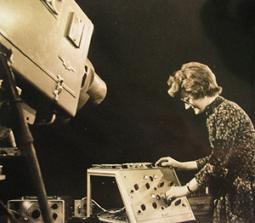Daphne Oram Collection
Article
Daphne Oram (1925-2003) is one of the central figures in the development of British experimental electronic music.

Early in her career she declined a place at the Royal College of Music to become a "music balancer" at the BBC, and as co-founder and first director of the BBC Radiophonic Workshop, she is credited with the invention of a new form of sound synthesis – Oramics.
Not only is this one of the earliest forms of electronic sound synthesis, it is noteworthy for being audiovisual in nature - i.e. the composer draws onto a synchronised set of ten 35mm film strips which overlay a series of photo-electric cells, generating electrical charges to control amplitude, timbre, frequency, and duration.
This system was a key part of early BBC Radiophonic Workshop practice. However, after Daphne left the BBC (in 1959), her research, including Oramics, continued in relative secrecy.
Daphne Oram died in 2003 and her life’s work passed into the care of Hugh Davies who knew Daphne and her work better than anyone in the UK. Following Hugh’s death in January 2005, Sonic Arts Network was asked by Daphne’s family to become custodians of her collected papers, recordings and other items. It was with experimental electronic music practice in mind that Goldsmiths College Electronic Music Studios have collaborated with the Sonic Arts Network to bring this collection into the academic community where it can be properly studied and developed.
The collection houses a number of important recordings, including some of her key works such as Pulse Persephone (1965), Bird of Parallax (1972), Rockets in Ursa Major (1962), Broceliande (1969-70), and the soundtrack to the feature film The Innocents (1961). There are also a number of professional showreels (including adverts for ICI and Heinz), and recorded lectures/demonstrations (for research purposes).
The collection also includes research documents detailing Daphne Oram's theoretical approaches and studies of electronic music, alongside early computer software relating to her compositional practice, instrument design and synthesis techniques. There are approximately 1000 papers, 200 7” reel-to-reel tapes, some 10” and 12” reel-to-reel masters, and a collection of floppy disks for the Acorn Archimedes and Apple II computer systems.
"Oram was the first (and only?) woman to design and build an entirely new sound recording medium."
(Hutton, J. 2003. Daphne Oram: Innovator, Writer and Composer. Organised Sound 8(1): 49-56. Camb: CUP).
The collection contains a great deal of personal correspondence, photographic documentation, and press cuttings. One of these items is a letter from Goldsmiths College in 1966, thanking Daphne for a demonstration of electronic music techniques. It is likely that this demonstration directly stimulated the beginnings of electronic music study at Goldsmiths.
Enquiries regarding the collection should be directed to Dr. Mick Grierson, Director of the Daphne Oram Collection - email (@gold.ac.uk), tel. 020 7919 7651.
Links
- Daphne Oram's website
- Daphne Oram, the unsung pioneer of techno (BBC News)
- Daphne Oram Oramics CD (2007) (at Paradigm Discs)
- Graham Wrench: The Story of Daphne Oram's Optical Synthesizer (article @ Sound On Sound)
- the 'Oramics' machine on display at the Science Museum, London
- Daphne Oram - Twitter feed
- 'Pioneering electronic instrument found in France' - New Scientist (Aug 2011) - including a video by Nick Street documenting the journey of the Oramics machine.